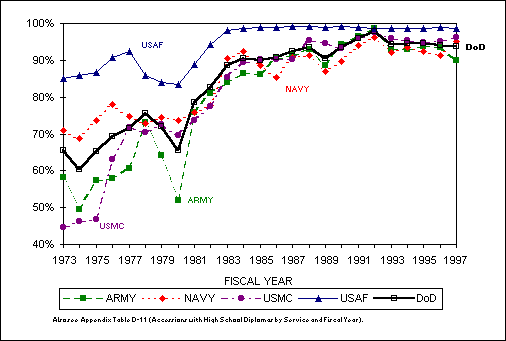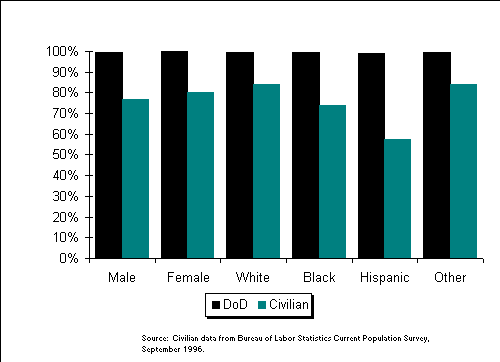|
More than 30 years of research indicates that enlistees who are high school graduates are much more likely
than non-graduates to complete their first term of enlistment (80 percent versus 50 percent).(24)
In the late 1960s and early 1970s, the Services gave high school graduates, including those with alternative education credentials, higher priority for enlistment. In the mid- to late 1970s,
the Army, Navy, and Air Force classified GED holders and high school graduates differently because evidence showed that persons with GED certification experienced higher first-term attrition. Today, in all
Services, applicants with GEDs need higher AFQT scores to enlist than do high school diploma graduates. Additional research indicates that those with
other alternative credentials, such as adult education and correspondence school diplomas, also have attrition rates greater than regular high school graduates.(25) In 1987, DoD implemented a three-tier classification of education credentials. Table 2.7 shows
the percentage of FY 1997 active duty NPS accessions by education tier. Ninety-four percent of recruits possessed high school diplomas and/or some college education (Tier 1); 5 percent held alternative high school
credentials (Tier 2); and less than one percent had not completed high school (Tier 3). It should be noted that enlisted occupations are generally comparable to civilian jobs not requiring college education.
Table 2.7 Levels of Education of FY 1997 Active Component NPS Accessions, by Service, and
Civilians 18-24 Years Old (Percent) |
Education Level1 |
Army |
Navy |
Marine
Corps |
Air
Force |
DoD |
18-24
Year-Old
Civilians* |
Tier 1: Regular High School Graduate or Higher |
90.0 |
95.0 |
95.9 |
99.1 |
93.9 |
|
Tier 2: GED,
Alternative Credentials |
9.9 |
3.0 |
2.5 |
0.6 |
5.3 |
78.8 |
Tier 3: No Credentials |
** |
2.0 |
1.6 |
0.2 |
0.8 |
21.3 |
Total
|
100.0 |
100.0 |
100.0 |
100.0 |
100.0 |
100.0 |
College Experience
(Part of Tier 1)2 |
10.0 |
3.7 |
2.9 |
19.6 |
8.6 |
45.5 |
Columns may not add to total due to rounding.
* Civilian numbers and percentages combine Tiers 1 and 2 as
civilian data include GED certificates with high school graduate rates.
** Less than one-tenth of one percent.
1 Service data from OASD(FMP)(MPP)/Accession Policy have been reviewed and updated by the
Services for official submission. Data presented in this table may differ slightly from the data shown in appendix tables that are taken from DMDC's USMEPCOM Edit File.
2 College experience data
from the Services are defined as those individuals with the following credentials: associate degree, professional nursing diploma, baccalaureate, master's, post master's, doctorate, first-professional,
or completed one semester of college.
Also see Appendix Tables B-7 (Education by Service and Gender) and B-8 (Education by Service and Race/Ethnicity).
Source: Service data from OASD(FMP)(MPP)/Accession Policy -- submitted in accordance with DoD Instruction
7730.56. USMC college experience from DMDC's USMEPCOM Edit File. Civilian data from Bureau of Labor Statistics Current Population Survey File, October 1996 - September 1997. |
While 99 percent of FY 1997 accessions were in Tiers 1 and 2, only 79 percent of 18- to
24-year-old civilians are high school graduates or possess a GED certificate. Differences among Services in FY 1997 high school graduate accessions are small, ranging from 99
percent (Air Force) to 90 percent (Army). The Army has the highest proportion of recruits with Tier 2 credentials (10 percent); the Air Force has the lowest (1 percent). In FY
1997, the Army enlisted less than one-tenth of one percent of applicants without education credentials; the other Services' acceptance of recruits with no high school credentials ranged from 0.2 to 2.0 percent.The proportion of accessions with high school diplomas by Service for FYs 1973 through 1997 is shown in Figure 2.5. During most of the first decade of the volunteer military (FYs
1973-1982), the Services differed significantly in the proportion of high school diploma graduates. In addition, there were significant variations across years. Across Services, the
proportion of accessions with high school diplomas fell from 75 percent in FY 1978 to 66 percent in FY 1980. The drop was most pronounced in the Army, declining from 73 to 52 percent over that period.
 |
Figure 2.5
. Active Component NPS accessions with high school diplomas, FYs 1973-1997.During the mid-1970s, the Services operated with reduced recruiting budgets. At the same
time, there were highly publicized reports of shrinking military benefits and significant gaps in pay comparability with the civilian sector. Media articles cited the hemorrhage of talent
from the Services due to loss of benefits, and the percentage of Servicemembers eligible for food stamps.
Because of lower education levels of new recruits, lower test scores, and increasing minority representation during this period, debates began on whether to replace the
volunteer force with either a form of national service or a return to the draft.(26)
The Executive and Legislative branches of government funded major initiatives to reinvigorate the volunteer military, enhance recruiting programs, and improve Servicemembers' quality
of life. Military pay and benefits and recruiting resources were increased substantially in 1981, resulting in a rapid increase in the quality of accessions. The proportion of high
school graduate recruits jumped from 66 percent in FY 1980 to 83 percent in FY 1982. Further incentives, such as the Montgomery GI Bill and the Army and Navy College
Funds, and the Services' emphasis on improving the quality of life for Servicemembers and their families led to improved recruiting. The proportion of high school graduates climbed
to 98 percent in FY 1992. As previously stated, in FY 1997 the proportion of high school diploma graduates was 94 percent.
Figure 2.6 compares FY 1997 accessions with civilians of similar age on the percentage of high school graduates (Tier 1) and those with alternative credentials (Tier 2), by gender and
race/ethnicity. While virtually all military recruits are in Tiers 1 and 2, the same is not true of 18- to 24-year-old civilians. Some dramatic differences in education level, by
race/ethnicity, are evident in Figure 2.6. Only 74 percent of Black civilians and 57 percent of Hispanic civilians have high school diplomas or alternative credentials. Given these
percentages, the Services' minority recruiting pool is limited. Thus, the race/ethnicity representation comparisons should be interpreted with these data in mind.
 |
Figure 2.6. FY 1997 accessions and 18-24 year-old civilians who earned high school
diplomas (Tier 1) or alternative credentials (Tier 2), by gender and race/ethnicity.Go to AFQT
- See Flyer, E.S., Factors Relating to Discharge for Unsuitability Among 1956 Airman Accessions to the Air Force (Lackland
AFB, TX: Personnel Research Laboratory, December 1959); Elster, R.E. and Flyer, E.S., A Study of the Relationship Between Educational Credentials and Military Performance Criteria
(Monterey, CA: Naval Postgraduate School, July 1981); and Lindsley, D.H., Recruiting of Women, presented to 1995 Committee on Women in the NATO Forces Conference, June 2, 1995.
go back
- Laurence, J.H., Military Enlistment Policy and Educational Credentials: Evaluation and Improvement (Alexandria, VA: Human Resources Research Organization, September 1987).
go back
- In December 1976, the Department of Defense released a report, The All Volunteer Force: Current Status and Prospects,
which listed seven alternatives to the all-volunteer military. On June 20, 1978, the Senate Subcommittee on Manpower and Personnel of the Committee on Armed Services conducted an extensive hearing,
Status of the All-Volunteer Armed Force, on the problems of a volunteer force and the need to examine alternatives to the all-volunteer military.
go back
|

